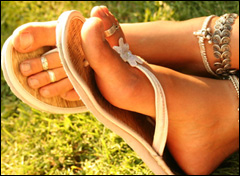Dear Umbra,
I saw an infomercial late at night about these foot pads that you wear to sleep and they will “remove toxins from your body.” I didn’t know who else to ask, so you win that lottery. Do we actually have that many toxins in our body? And does wearing silly pads on our feet really pull them out so we can easily throw these toxins in the trash? I think you should do an experiment and let me know if I’m missing the boat by not ordering right away — or if I should save energy that will be used by ordering, shipping, and discarding used foot pads.
Elizabeth
Washington, D.C.
Dearest Elizabeth,
Anything you see for sale on late-night TV is guaranteed to be useful. Worth every penny. I asked our comptroller for a credit card so that I could do your suggested experiment. He said no. I’m not a responsible late night shopper (after the Ginsu knife incident), and Grist is all wrapped up in testing nail polish, toothpaste, and organic beer. No time for toxin-sucking foot pads.
Let’s see what the internet tells us about foot pad-related toxins in our body. Looks like we have metabolic wastes, parasites, chemicals, mucus (!), cellulite (?!?), “toxins” — and eww, there’s a “before” and “after” photo of the footpatch! Bleagh. It’s a convincing photo, but I wouldn’t undertake such an operation without consulting a professional.
What are toxins, and do we indeed have them inside us? Toxins are traditionally defined as poisons derived from living organisms (e.g., tetanus). Today the term is widely used to mean anything known to be poisonous or suspected to cause ill health. Inquiring into toxins can lead to the dubious world of New Age cure-alls, perhaps including these foot pads. But there’s no disputing the sad fact that humans have introduced harmful poisons into the general environment, and many of these very same poisons may be found in our bodies. Our “body burden” includes chemical pollutants from pesticides, flame retardants, treated wood, lead paint, animal fats, cosmetics, and more. Some of these wafted through the air to our lungs; others we ate. Various studies have tested human blood, hair, and urine for chemicals, and delivered bad news. In just a few examples: breast milk contains persistent bioaccumulative toxics (PBTs) and persistent organic pollutants (POPs), such as dioxins, furans, and PCBs. Bill Moyers had 87 out of 214 tested substances, including lead and methylmercury, in his body; some of his fellow Human Toxome Project subjects had more than 100. Ten Washingtonians who were tested for toxic chemicals all had phthalates, PCBs, and mercury in their samples. Many of these chemicals are known or suspected to damage us in some way, be it in our endocrine system, our brain, or our reproductive organs.
Our existing body burden diminishes as water-soluble pollutants exit in our sweat, urine, and other watery outputs; mercury also exits through our hair and nails. Fat-soluble chemicals, however, will only leave us if we lose the fat in which they are stored. Taking those factors into account, we can help cleanse ourselves by losing weight, reducing our exposure to harmful chemicals, and letting our body burden decline via the natural excretion process.
Personal steps to reduce chemical exposure include eating lower on the food chain and eating low-mercury fish, using furniture free of PBDE flame retardants, and avoiding pesticides, solvents, and smoking … stuff we’ve oft discussed in this space. Find more information on what to avoid from the Environmental Working Group, the Natural Resources Defense Council, Pollution in People, or the Grist archives (search for “body burden” or “environmental health,” and voila). We each have a major role to play in reducing community exposure to these chemicals. Our consumption habits have the potential to contribute to chemical pollution (vinyl production emits dioxin, to mention one favorite dead horse), or to promote a cleaner way of life (emitting less car exhaust via driving fewer miles per week, to mention another dead horse).
Which brings us back to whether or not one should buy a product of dubious value advertised on late-night television. Eschewing late-night shopping is excellent personal environmental policy, and the omnipresence of chemicals in the manufacture of stuff is one additional reason. Buying less stuff is an important toe on our eco-footprint. If anyone has news about toxin-removing foot pads, or how cellulite and mucus count as toxins, please write in. Until then, let us refrain from any unnecessary shopping, and simply wrap moist toilet paper about our feet. See where that gets us.
Gamely,
Umbra



